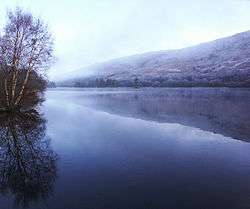Loch Oich
Loch Oich (/ˌlɒx ˈɔɪx/; Scottish Gaelic: Loch Omhaich) is a freshwater loch in the Highlands of Scotland which forms part of the Caledonian Canal, of which it is the highest point.[1] This narrow loch lies between Loch Ness (to the Northeast) and Loch Lochy (to the Southwest) in the Great Glen.[2] It is fed by the River Garry (from Loch Garry) from the West, and feeds the River Oich from its North end. The Laggan locks separate it from Loch Lochy.
| Loch Oich | |
|---|---|
 | |
| Location | Highlands of Scotland |
| Coordinates | 57°4′N 4°47′W |
| Type | freshwater loch |
| Basin countries | United Kingdom |
| Max. length | 6.5 km (4 mi) |
| Max. width | 1 km (0.62 mi) |
| Max. depth | 47 m (154 ft) |
| Surface elevation | 32 m (106 ft) |
The Loch Oich wildlife is rich with a wide variety of fish, amphibians, reptiles, birds and mammals.
Every autumn the Atlantic salmon (Salmo salar) migrates from the sea using Loch Oich, Loch Lochy and Loch Ness as their spawning nests. After two years when the fingerling are up to 20 cm (8 in) long they migrate back to the sea where they grow rapidly and weigh from 3.5–17 kg (8–37 lb) after two years.
Thomas Telford artificially raised the level of the loch by many feet to provide a navigable channel for the Caledonian Canal.[3] The tall needle like monument on the banks of loch Oich is topped by a sculpture of a hand holding a dagger and seven severed heads. On September 25th 1663, Alexander, the 13th chief of the Keppoch family, powerful members of the Mac Donald's, and his brother Ronald were killed by their cousins at a brawl in the mansion of Insch, just outside of the village of Roy Bridge. The killers were well known, Alexander Macdonald and his six sons from Inverlair . Sir James at Dunelm castle was persuaded by Bald Iain to apply to the privy council in Edinburgh for letters of fire and sword to lawfully revenge their deaths. The seven known killers were murdered and decapitated, their heads washed by the loch and taken to Edinburgh where they were affixed to th gallows between Leith and Edinburgh. The monument at the side of A82 was erected in 1812, and the story was proven by the exhumation of a mound on the lands of Inverlair, where at least seven headless corpses were found.
References
- "The Gazetteer for Scotland". Archived from the original on 2010-09-17.
- "Bathymetrical Survey of the Fresh-Water Lochs of Scotland, 1897-1909". National Library of Scotland. Archived from the original on 2007-02-08.
- "Scottish Canoe Association". Archived from the original on 2010-04-18. Retrieved 2010-03-17.